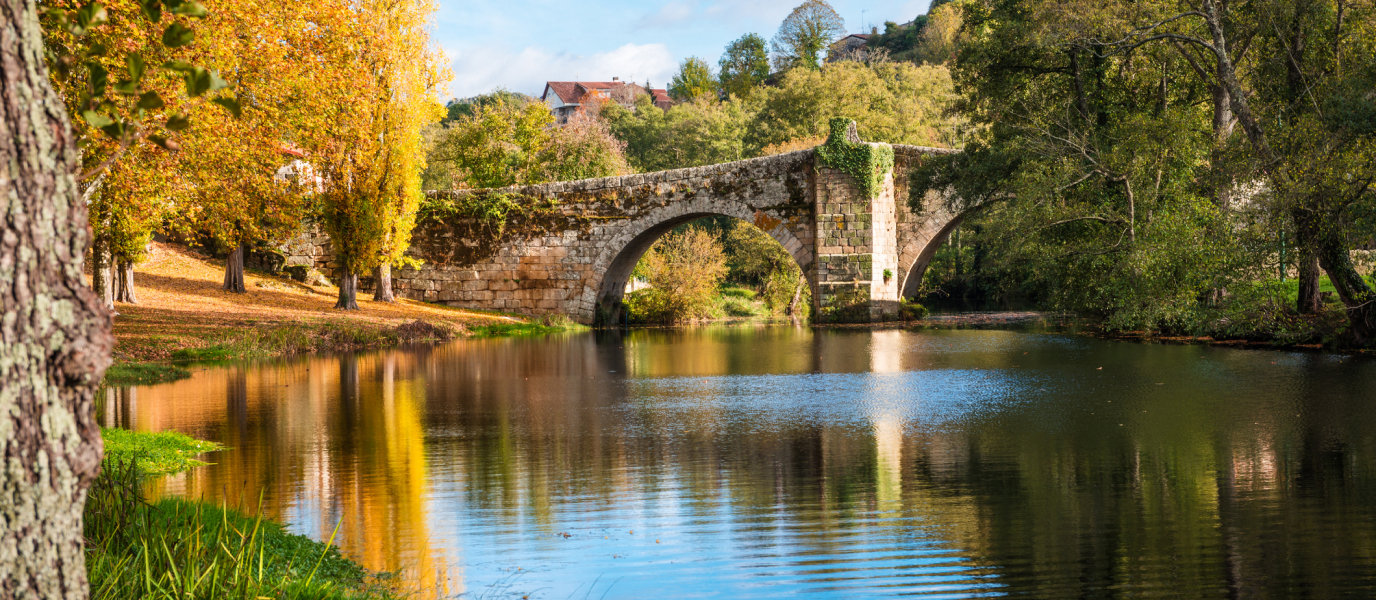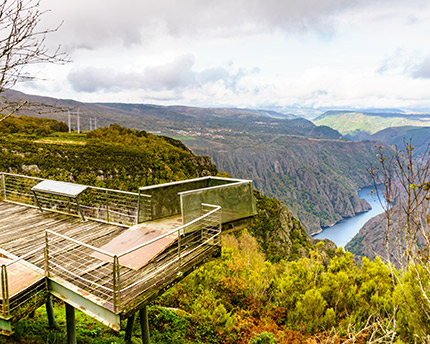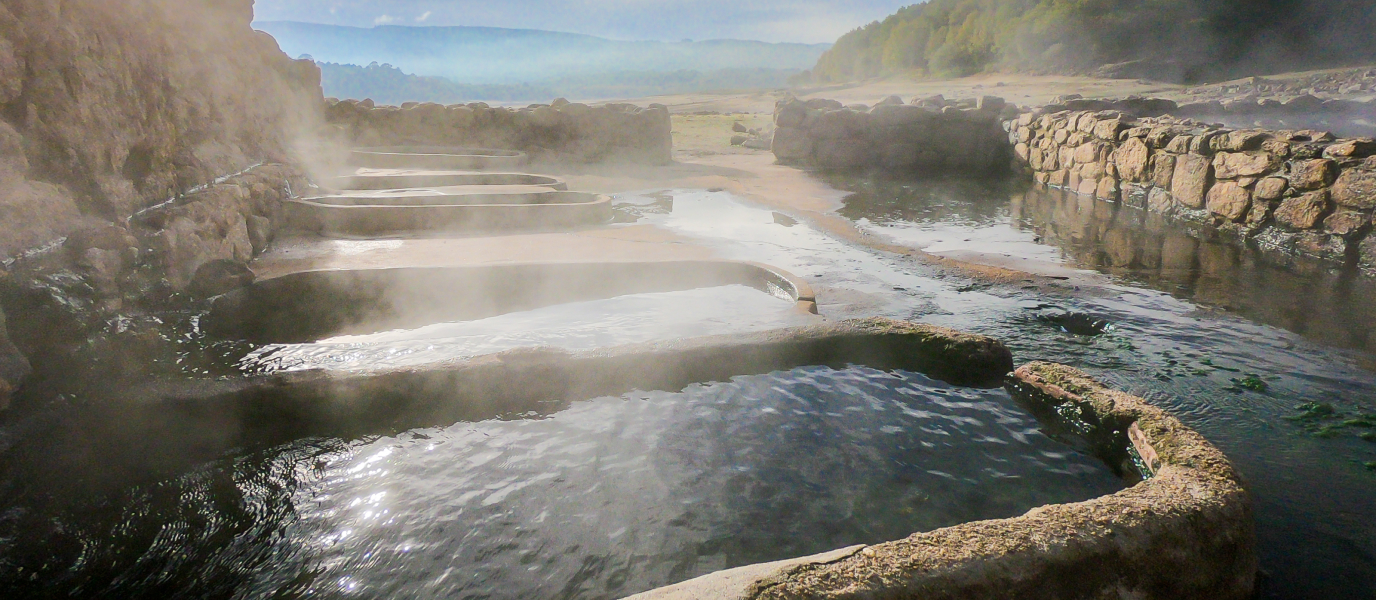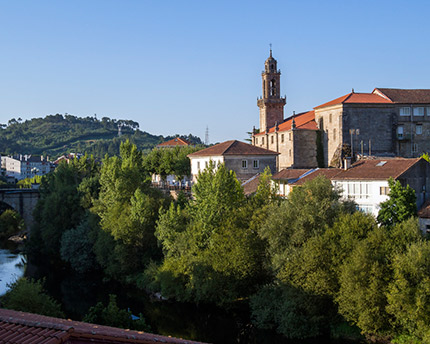An example of successful heritage regeneration to the point where it was awarded the European Town Planning Prize in 1994, the roots of the Ourense town of Allariz stretch back far in time (to at least the sixth century) and offer, in the present day, a flawless Site of Historic and Artistic Interest. Its mansions, narrow streets, squares, and great historical edifices recall a time of medieval splendour that is endlessly captivating to us, and which imbues this typical inland Galician town with an irresistible appeal.
Of course, in addition to its architectural treasures, Allariz offers an extraordinary natural heritage starting with the river Arnoia iteself and the Biosphere Reserve of Allariz — along with an exceptional multiplicity of artistic and cultural attractions, ranging from museums to a unique gastronomy and traditional festivals. In a nutshell, this is one of those places that enthrals visitors from the moment they arrive.
The Historic Quarter of Allariz
A Site of Historic and Artistic Interest since 1971, Allariz’s Historical Quarter is, above all, a clear testament to the former wealth and importance of this town. Among its many claims to fame, Allariz was named a Villa Real [Royal Town] by Alfonso VII of León in the twelfth century, and Alfonso X ‘The Wise’ spent part of his childhood in this corner of the province of Ourense — a vital stage in his life reflected in some of his famous Cantigas, which were written in Galician Portuguese. The town’s long history has been ‘written’ in stone, and now we can enjoy ‘reading’ it, largely thanks to the ambitious restoration initiative that received the European Town Planning Prize in the mid-1990s.
To wander around the streets of Allariz’s Historic Quarter is to explore and enjoy historic treasures such as the Church of Santiago (twelfth – thirteenth centuries), a key example of Galician Romanesque architecture; another Romanesque church, that of Santo Estevo, built in the twelfth century, but modified in the sixteenth century, the A Paneira mansion, an old mount of piety and agricultural credit institution which operated between the fifteenth and eighteenth centuries; the Casa-Torre de Castro Ojea, a fortified house dating from the sixteenth century and with a Baroque façade added in 1748; the remains of the old town walls and of its important Jewish quarter, among other historic treasures.
Convento de Santa Clara
Spain’s largest Baroque cloister (built in the thirteenth century on the express wish of Queen Violante, wife of Alfonso X ‘The Wise’, and rebuilt in the eighteenth century), the Royal Monastery of Santa Clara de Allariz is a true marvel that has evolved over time and survived various historical events that have threatened its very existence, from being vacated due to disentailment to the upheavals of the French invasion.
Today, the community of cloistered Poor Clares still lives in this great edifice, but the church is open to visitors, as is the fascinating Museum of Religious Art, which contains treasures such as the ivory carving of the Virgen Abrideira and the rock crystal Cruz de Cristal, given to the convent by Queen Violante herself.
Church of San Beito
To one side of the Convento de Santa Clara, on the southern boundary of the Campo da Barreira, stands this jewel of eighteenth-century Baroque architecture, built in honour of the town’s patron saint. The church’s Latin cross floor plan, its bell-tower, vaulting and great cupola combine to produce a simple, solemn image, which is nonetheless beautiful and harmonious. The main altarpiece, dedicated to Santiago [St James] is in the Renaissance style, and dates from the sixteenth century.
In addition, in front of the church, there are two Gothic crucifixes depicting the crucified Christ and the Virgin Mary: two examples of the outstanding collection of crucifixes erected following the three plague epidemics that occurred in the late sixteenth century, and which can be seen in various locations around the town.
Vilanova Bridge
Built during the last year of the twelfth century and the early thirteenth century, but rebuilt in the sixteenth century following severe flood damage, this impressive bridge, of Romanesque origin, is one of the undisputed symbols of the town. Its two great arches span the river Arnoia on its winding course that begins to the north of the historic quarter; ever since it was built, it has been an important crossroads on the Camino de Santiago, and especially on pilgrimages that depart from the Vía de la Plata or from the Camino Mozárabe.
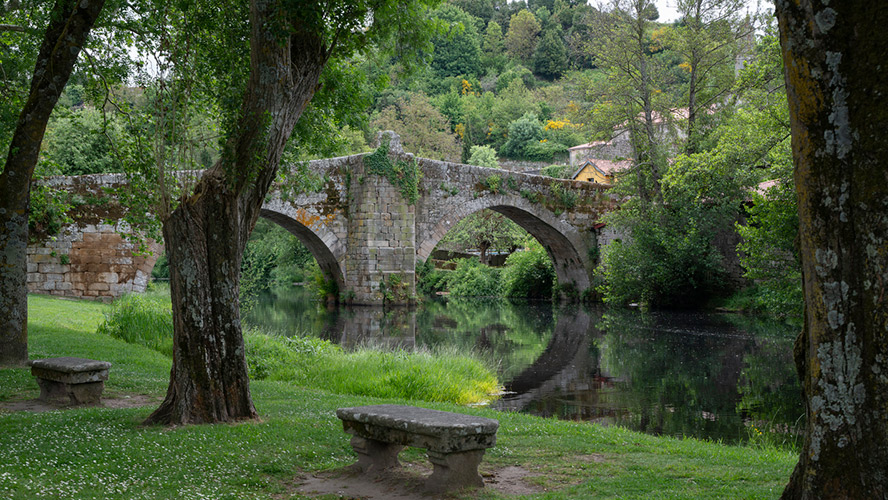
The riverside setting is also one of the great attractions of this corner of Allariz, with its extensive green areas on both sides of the river, and the nearby Romanesque church of Santa María de Vilanova, which dates from the twelfth century and is associated with the Order of Malta. An essential stop on your itinerary.
Allariz’s riverside beaches
Continuing along the bank of the Arnoia, this amazing natural setting offers spots where you can spend a leisurely interlude fishing, boating, walking along the various paths that edge the river, eating and drinking in the old windmills converted into restaurants, relaxing in the shade of the lush trees or, in summer, simply cooling off in the crystal-clear waters of the river.
The areas known as Acearrica, to the north, and the Campo de Vilanova and Arnado, in the area around the Romanesque bridge, are the main recreation grounds on the banks of the Arnoia — although the spot further downriver, on the right-hand bank where the famous Allariz International Garden Festival is held every year, is another not to be missed.
The Allariz Area Biosphere Reserve
The natural surroundings are, without question, one of the main attractions of this part of the province of Ourense. So much so that a good proportion of Ourense’s municipalities, including Allariz, Vilar de Santos, A Bola, and Rairiz de Veiga have formed part of the UNESCO Allariz Area Biosphere Reserve since 2005. This area of over 21,000 hectares provides a setting for the harmonious coexistence of southern Galicia’s natural, historical and cultural wealth.
The Reserve, bounded by the rivers Arnoia and Limia, offers all kinds of attractions in terms of its fauna and fauna (both domestic animals, such as its flocks of sheep and goats, and wildlife, with its emblematic eagles and wolves), its various hiking trails, and several interpretation centres. Then there’s its rich historical heritage (including Roman and pre-Roman archaeological sites, medieval and ethnographic treasures), its delightful riverside walks, and more. A wonderful natural and human mosaic that, above all else, demonstrates that it is possible to live in harmony with nature.
Museo do Coiro
Culture, art, crafts, tradition… all play a key role in the history of this amazing town, and contribute to the plethora of attractions it offers the visitor. And Allariz’s fascinating museums are an important aspect of all this.
One example is the Museo do Coiro [Leather Museum], a historical and ethnographic exhibition centre on the right bank of the Arnoia in the old leather factory that belonged to the Nogueiras family, where visitors can see the complete process of leather production. This great, eighteenth century edifice, with a square floor plan, is built around a central courtyard, and not only shows the importance of leather tanning in Allariz, but also displays all kinds of tools, machinery and other artefacts showing all the stages of the tanning process.
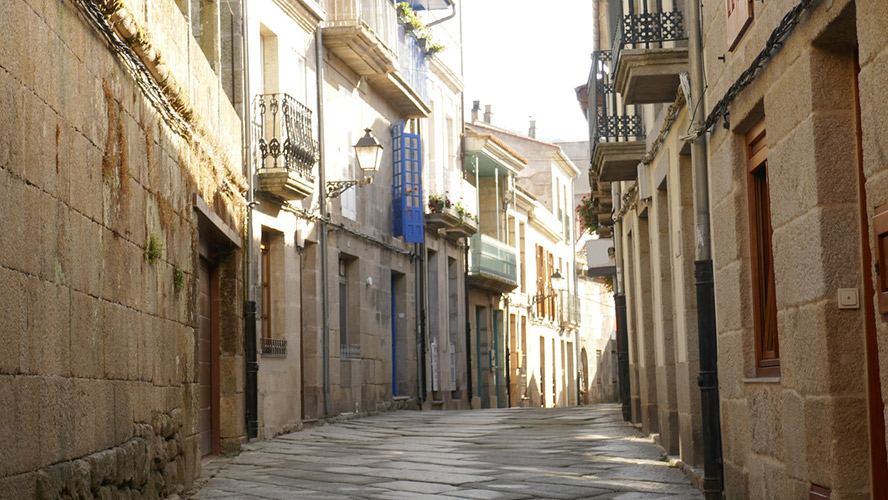
Museum of Religious Art
This remarkable collection is housed in three small buildings belonging to the huge Convento de Santa Clara. Some of the highlights are the Virgen abrideira, a small, late eighteenth-century carving in ivory and ebony (depicting scenes from the life of the Virgin and the Child), and the outstanding Crystal Cross, which shows many interesting Gothic gold work techniques and materials (gilded silver, enamelling, and so on); both these pieces were a gift from Queen Violante, the founder of the Convent and the wife of King Alfonso X (Alfonso The Wise).
This fascinating collection is augmented by various examples of gold work and sculpture, including monstrances, chalices and reliquaries, and even a few strange granite lions, used as supports for burial mounds, along with other historical treasures.
Toy Museum
Housed in a late seventeenth-century stately mansion in the heart of Allariz’s historical quarter, this unusual museum opened in 1994, following the donation of an extraordinary collection of almost 600 toys of various types and from different periods (ranging from the early twentieth century until the 1960s) by a resident of the town, Alberto Oro Claro. Other subsequent donations have increased the museum’s holdings to 1,500 pieces, all representative of different decades of the last century. The Museo Galego do Xoguete de Allariz is a pleasant and novel experience combining ingenuity and nostalgia.
Other fine examples of this remarkable medieval town are its Fashion Museum, and the Casa-Museo Fundación Vicente Risco. Another place of interest is the Ecoespazo do Rexo [Rexo Ecospace], in the neighbouring parish of Requeixo de Valverde, which includes an installation by the Basque artist Agustín Ibarrola, a mini waterwheel, a pilot scheme rearing sheep for milking, and a cheese making operation.
Where to eat in Allariz
Its cuisine is one of the town’s indisputable attractions, and before (or after) enjoying the area’s rich historical heritage and its lush natural surroundings, visitors should try some of its most typical dishes: the local beef, sausages, artisan beers, the fruit from the area’s orchards, the cheeses, and the traditional pastries.
The finest of Allariz’s gastronomic delights (from tapas and small plates to more sophisticated, classic Galician cuisine, both traditional and modern) is offered by establishments in and around the historic quarter, such as Pallabarro, in Rúa Sur; Bule Bule, in the Praza de Abaixo; Petiscos and BoiGorri, both in Rúa Portelo; and Fogar do Santiso, a most unusual restaurant-museum located at the foot of the Vilanova bridge — as well as many others.
Where to stay near Allariz
After a tremendously enjoyable visit to the medieval town of Allariz and the area around, nothing could beat a first-class stay at the Barceló Ourense hotel (https://www.barcelo.com/es-es/barcelo-ourense/) Located right in the heart of the “City of Water”, this modern, four-star hotel run by the Barceló Group offers various types of rooms, all fully equipped to the B-Room standard. Other services and facilities include a fitness room and sauna (both free to guests), and a thoughtfully designed restaurant menu.




































































